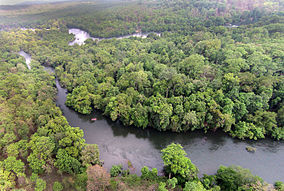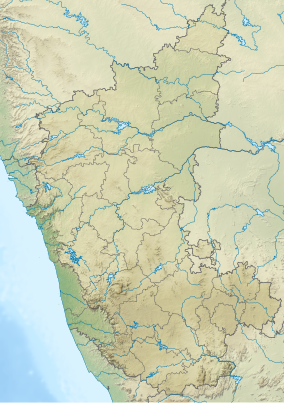Kali Tiger Reserve: Difference between revisions
m " http://www.karnatakawildlifeboard.org/NationalParks/AnshiNationalPark/AnshiNationalParkAccommodation.aspx " is dead link so i have updated it with another page about dandeli from " http://www.dandelijungleresorts.in/Dandeli " |
Added map of Karnataka Tags: Mobile edit Mobile web edit |
||
| Line 9: | Line 9: | ||
| photo_caption = Kali river flowing through Kali Tiger Reserve |
| photo_caption = Kali river flowing through Kali Tiger Reserve |
||
| photo_width = |
| photo_width = |
||
| map = India |relief=1 |
| map = India Karnataka#India|relief=1 |
||
| map_alt = |
| map_alt = |
||
| map_caption = Location in Karnataka, India |
| map_caption = Location in Karnataka, India |
||
Revision as of 17:51, 31 May 2019
| Kali Tiger Reserve | |
|---|---|
| Kali Tiger Reserve | |
 Kali river flowing through Kali Tiger Reserve | |
| Location | Uttara Kannada district, Karnataka, India |
| Nearest city | Dandeli |
| Coordinates | 15°1′N 74°23′E / 15.017°N 74.383°E |
| Area | 1,300 km2 (500 sq mi) |
| Established | 2 September 1987 |
| Governing body | Principal Chief Conservator of Forests (Wildlife), Karnataka |
| Official website | |
Kali Tiger Reserve (Kannada: ಕಾಳಿ ಹುಲಿ ಸಂರಕ್ಷಿತ ಪ್ರದೇಶ ) is a protected area and tiger reserve. It is located in Uttara Kannada district, in Karnataka, India. The park is a habitat of Bengal tigers, black panthers and Indian elephants, amongst other distinctive fauna. The Kali River flows through the tiger reserve and is the lifeline of the ecosystem and hence the name. The Tiger reserve is spread over an area of 1300 square kilometers.
History
The forest in the area was declared the Dandeli Wildlife Sanctuary on 10 May 1956. The state proposed carving out a section of the sanctuary to form the Anshi national park, and the proposal was implemented on 2 September 1987.[1] The initial proposal covered 250 square kilometres. When the final notification of the park area was issued in 2002, it was extended by another 90 square kilometres.
It was renamed to Kali Tiger Reserve in Dec 2015.
The park is home to several hydroelectric dams and a nuclear power station.
Renaming of Anshi Tiger Reserve
It is notable that Anshi National Park and Dandeli Wildlife Sanctuary were together granted the status of Project Tiger tiger reserve, being declared as 'Anshi Dandeli Tiger Reserve' in January, 2007.[2] The 340 km2 (130 sq mi) Anshi park adjoins the Dandeli Wildlife Sanctuary, and together with six adjacent protected areas in the states of Goa and Maharashtra, forms an almost uninterrupted protected forest area of over 2,200 km2 (850 sq mi).
In December 2015, Dandeli Anshi Tiger reserve was renamed to Kali Tiger Reserve(JOIDA).[3] The river Kali is the lifeline of the people of Uttara Kannada district and integrates Dandeli Wildlife Sanctuary (DWS) spread across 400 km2 and Anshi National Park (ANP) spread across 500 km2. The river cuts across the whole park and the renaming has given the area a single identity. The change of name was also to bring focus and awareness to Kali River (Karnataka). The name change was prompted following a universal response from policymakers after the release of the movie Kali[4][5] which brought to importance the role of Kali River to the ecosystem.
Geography
Located in the Western Ghats range from l4°54' to l5°07' N latitude and 74°l6' to 74°30’ E longitude, Kali Tiger River's elevation varies from 27–1,059 m (89–3,474 ft) above MSL. Despite high rainfall in this area, water holes go dry very early in the summer because the soil is laterite, with minimal water-holding capacity.[6]
Park management
The management of National parks and sanctuaries in the state is the responsibility of the Principal Chief Conservator of Forests (Wildlife). Kali Tiger Reserve is headed by the Director of the Park who is also the Chief Conservator of Forests.
Flora


The park is in the ecoregions of North Western Ghats montane rain forests and North Western Ghats moist deciduous forests, both of which are deemed endangered by the World Wide Fund for Nature (WWF).[7] The forests have high biodiversity.
Some common trees and plants here include: bintangur, Calophyllum wightianum, Malabar tamarind, Garcinia morella, Knema attenuata, Hopea wightiana, Tetrameles nudiflora, blackboard tree, Flacourtia montana, Machilus macrantha, Carallia brachiata, aini-maram, Artocarpus lacucha, true cinnamon, bamboo, bauhinia, eucalyptus, lantana, silver oak, teak and jamba.[8]
Fauna
The black panther,[9] elephants and tigers live in the park but are rarely seen. Other large mammals here are Indian bison, sloth bear, Indian wild boar, bonnet macaque, northern plains gray langur, gray slender loris, several deer including: barking deer (muntjac), mouse deer (chevrotain), sambar deer and spotted deer (chital or axis deer).
Wild dog, jackal, jungle cat, leopard cat, small Indian civet, Indian gray mongoose, flying squirrel, porcupine, Malabar civet, Indian giant squirrel and pangolin also make their home in the forests here.
Reptiles in the park include the king cobra, spectacled cobra, Russell's viper, saw-scaled viper, common krait, Indian rock python, rat snake, vine snake, green or bamboo pit viper and monitor lizards.
Interesting birds include the Ceylon frogmouth, great hornbill, Malabar pied hornbill, Malabar grey hornbill, Indian grey hornbill and Asian fairy bluebird. Around 200 species of birds are recorded in the park. These include the distinctive adjutant stork, ashy woodswallow, black-crested bulbul, blue-headed pitta, brahminy kite, broad-billed roller, crested serpent eagle, great hornbill, golden-backed woodpecker, Malabar pied hornbill, Sri Lanka frogmouth and yellow-footed green pigeon.[8]
Visitor information
The best months to visit are October to May. The park is open from 6:00 am to 6:00 pm. The nature camp at Kulgi has accommodations available in tents (two beds each), deluxe tents (two beds each), and a dormitory with 16 beds. The climate is quite humid year around. The usual plans are visiting the Bird Trail, Mammal trail in Kulgi which is a 3-km walk. The water sports like jacuzzi, boating, rafting, and canoeing can be planned in the river Kali, and trekking the extremely beautiful Dudhsagar waterfalls by a 20-km trek is also available.
Signboards are written in Kannada and English.
Dandeli is the nearby town adjoining sanctuaries which has daily bus services to Dharwad, Hubballi, Belagavi and Bengaluru.Visiting the eco interests in Goa is optional. The local vegetarian food is served.[10]
References
- ^ Wildlife Institute of India Protected Areas in Karnataka state Archived 24 December 2004 at archive.today, (June 2000), URL accessed 2 April 2007
- ^ Rajendran, S (17 January 2007), "Karnataka gets its fourth Project Tiger sanctuary", The Hindu, Chennai, India, retrieved 6 March 2007
- ^ Bosky Khanna (23 December 2015). "Anshi-Dandeli reserve now Kali tiger reserve". Deccan Herald. Retrieved 20 March 2015.
- ^ kali rename
- ^ "IMDb Title: Kali".
- ^ "About the park", National Parks - Anshi National Park, Karnataka State Wildlife Board, 2011, retrieved 8 March 2012[permanent dead link]
- ^ WWF "North Western Ghats moist deciduous forests". Terrestrial Ecoregions. World Wildlife Fund. Retrieved 6 March 2007.
- ^ a b "Flora and Fauna", National Parks - Anshi National Park, Karnataka State Wildlife Board, 2011, retrieved 8 March 2012[permanent dead link]
- ^ Black panther in India Archived 20 January 2013 at the Wayback Machine
- ^ |author = Shivaraj Shettar |url = http://www.dandelijungleresorts.in/Dandeli |title = Accommodation |work = National Parks - Anshi National Park |publisher = Karnataka State Wildlife Board |year = 2011 |accessdate = 8 March 2012
External links
- Map National Parks and Wildlife Sanctuaries of Karnataka
- Use dmy dates from June 2013
- IUCN Category II
- Tiger reserves of India
- National parks in Karnataka
- Wildlife sanctuaries of the Western Ghats
- Important Bird Areas of India
- Wildlife sanctuaries in Karnataka
- North Western Ghats moist deciduous forests
- North Western Ghats montane rain forests
- Protected areas established in 1987
- 1987 establishments in India
- Tourist attractions in Uttara Kannada district


